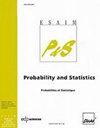变带宽核回归估计
IF 0.7
4区 数学
Q4 STATISTICS & PROBABILITY
引用次数: 1
摘要
为了改进经典的Nadaraya-Watson估计,我们提出了一种用于i - id观测值的变带宽核回归估计。在密度函数的五阶导数和回归函数的六阶导数有界且连续的条件下,将偏差提高到O(hn4)阶。我们还建立了理想变量核回归估计量和真变量核回归估计量的中心极限定理。仿真研究证实了我们的结果,并证明了变带宽核方法相对于经典核方法的优越性。本文章由计算机程序翻译,如有差异,请以英文原文为准。
Variable bandwidth kernel regression estimation
In this paper we propose a variable bandwidth kernel regression estimator for i.i.d. observations in ℝ2 to improve the classical Nadaraya-Watson estimator. The bias is improved to the order of O(hn4) under the condition that the fifth order derivative of the density function and the sixth order derivative of the regression function are bounded and continuous. We also establish the central limit theorems for the proposed ideal and true variable kernel regression estimators. The simulation study confirms our results and demonstrates the advantage of the variable bandwidth kernel method over the classical kernel method.
求助全文
通过发布文献求助,成功后即可免费获取论文全文。
去求助
来源期刊

Esaim-Probability and Statistics
STATISTICS & PROBABILITY-
CiteScore
1.00
自引率
0.00%
发文量
14
审稿时长
>12 weeks
期刊介绍:
The journal publishes original research and survey papers in the area of Probability and Statistics. It covers theoretical and practical aspects, in any field of these domains.
Of particular interest are methodological developments with application in other scientific areas, for example Biology and Genetics, Information Theory, Finance, Bioinformatics, Random structures and Random graphs, Econometrics, Physics.
Long papers are very welcome.
Indeed, we intend to develop the journal in the direction of applications and to open it to various fields where random mathematical modelling is important. In particular we will call (survey) papers in these areas, in order to make the random community aware of important problems of both theoretical and practical interest. We all know that many recent fascinating developments in Probability and Statistics are coming from "the outside" and we think that ESAIM: P&S should be a good entry point for such exchanges. Of course this does not mean that the journal will be only devoted to practical aspects.
 求助内容:
求助内容: 应助结果提醒方式:
应助结果提醒方式:


